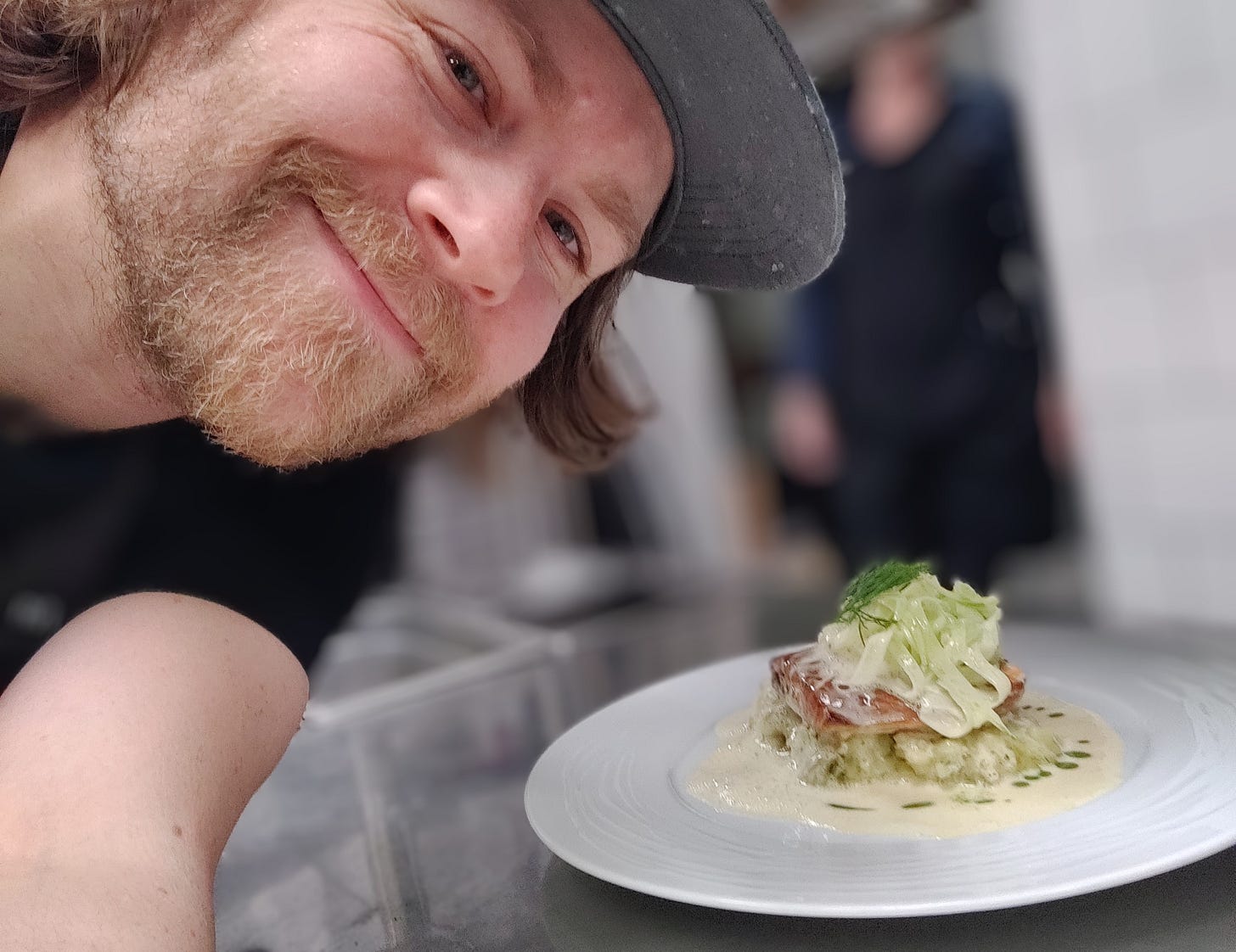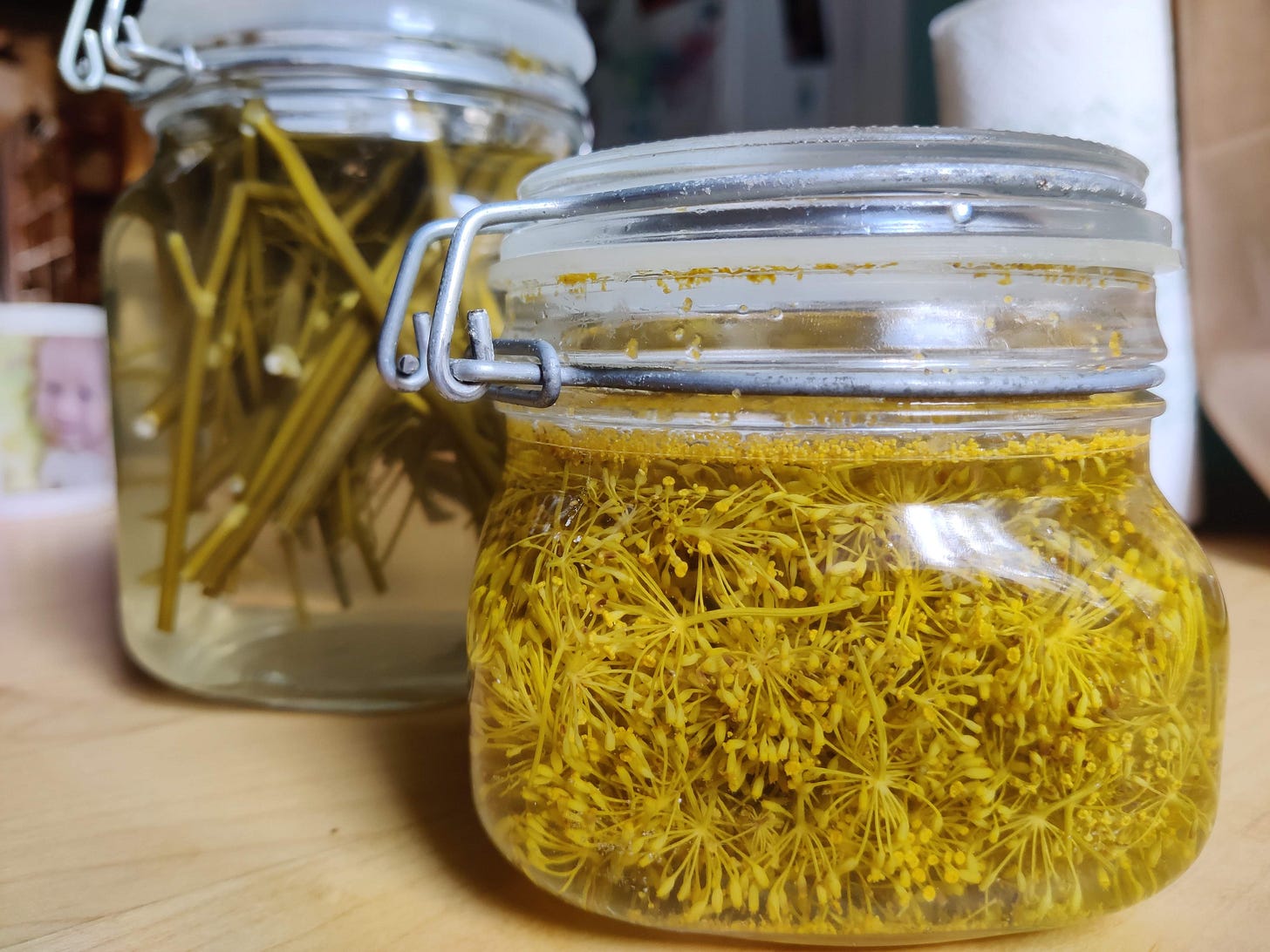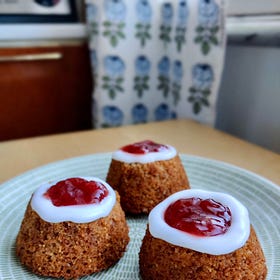Notes from a Nordic Kitchen
Advice and tips to make your cooking a little more "Nordic"
Dear friend, welcome back to The Recovering Line Cook.
Everyone loves sharing what they’re passionate about with others, right? Well, I really love the food I’ve worked with as a restaurant cook in Sweden and Finland, and telling people about it is a joy for me.
This week I’m sending you a practical counterpart to my previous essay on what Nordic food means to me.
I could write an entire book about this of course but, until I do, I hope these notes on some of my favourite aspects of Nordic food help as well.
Wil
1: Be led by seasonal and local produce…
I know, I KNOW, OK! This one is so fucking clichéd and obvious I might as well start by telling you not to fry bacon naked and to eat with your mouth closed.
But I really think not opening with this would be to miss out one of the joys of Nordic life: the arrival of a favourite fruit or vegetable, from a nearby farmer, after the long winter months.
In early summer, for example, stalls will magically pop up all over the place in Finnish towns selling strawberries and pea pods side by side. This, not to mention the first new potatoes in spring and crayfish in August, is a genuine cultural event.
I asked my old friend Jacco, previously my head chef at Oaxen Slip in Stockholm and now owner of this beautiful guest lodge, what his favourite aspect of Nordic food was. The first thing he mentioned was seasonality and the way it differs in Nordic countries to his home country of The Netherlands:
“The seemingly endless hunt or search for high quality ingredients comes with what I really enjoy: the following of the seasons. The joy of the first bits of some specific produce gets me excited all the time. That for me is maybe the biggest difference with cooking in the Netherlands, for example, where seasons are so much less present.
“I like my food brown in the winter.”
Outside any environmental benefits, the other reason eating seasonally can be so positive is for how great an aid it is for creativity in the kitchen.
If you’re like me, total creative freedom can be really… inhibiting. My pathetic human brain is really bad at creating something from absolutely nothing. By considering the seasons, restricting myself to only what is best at any given moment, I find my ideas flow that bit better.
How to do it yourself: Let the season dictate your ingredients and leave yourself only to worry about how to get the best from them the way you enjoy the most.
… and there’s nothing more seasonal and local than foraging
What I love about life in Sweden and Finland is how normal, how everyday, foraging is. This hyper-seasonal pursuit isn’t something done with lots of planning and a registered instructor or a licence, it’s just something done during a walk in the forest.
It is the depths of winter here in Finland right now, but in the next few weeks (or months depending on when spring arrives), look out for a post from me on my favourite foraged ingredients and how I use them in the kitchen.
But one of the great things I’ve learnt here as a cook is that foraging doesn’t end with fresh herbs and vegetables. Foraging also means making use of ingredients you might not have considered ingredients at all.
Learning how to use wood itself in food has been a big part of this. Charred pieces of juniper tree make the most incredible aged vinegar. And charcoal can be used to make the most unique flavoured butter. Using these flavourings adds a very special Nordic perfume to dishes.
2: Don’t eat seasonal
Having said that, if you expect to eat seasonally and locally anywhere as cold as Finland, there’d be significant parts of the year in which all you’d eat for dinner was moss and variations of roast squirrel.
I suppose that’s why, in many ways, the story of Nordic food is the story of how one preserves the goods of the fertile season for the long winter.
Pickled and fermented food
My ideal plate of Nordic food makes liberal use of pickled or fermented items. A garnish of pickled onions or beetroot to cut through the richer elements on the plate. Brine from preserving ramson berries to elevate a sauce with perfumed acidity. The crunch of pickled carrots. All these elements help create a dish of contrasts that, bite after bite, never becomes boring.
Fermentation is a superpower. It makes things taste great, it preserves them and according to people more intelligent than me, it makes healthy things even healthier.
Best of all, despite what you may think, fermentation doesn’t have to be complicated or scary. It’s often just a matter of weighing a few things, making some salt water, and keeping an eye on them for a few days. I promise you, a deep-fried fermented potato is an absolute dream starter served with sour cream, pickled cucumbers and caviar.
How to do it yourself: Add some fermented cucumbers, sliced pickled onions or pickled turnips to your plate the next time you have a hearty stew or casserole. The acidity and crunch is a great contrast to rich things.
Smoke
I’m going to defer to a far greater chef than me to elaborate here. On the importance of smoked food to Nordic cuisine, I’d like to share some words from the owner and creative genius behind the two-Michelin star Stockholm restaurant Oaxen Krog: Magnus Ek. He told me this week:
“I’ve always loved smoked foods, not just for its deep, rich flavour but because it’s one of the oldest preservation techniques. Smoking doesn’t just extend the life of a product, it transforms it. The process enhances flavour, alters texture, and creates endless possibilities. Nearly anything can be smoked, and the final result depends on so many factors: how warm the smoke is, how much salt is used, and the time it’s given to develop.
“It’s a perfect balance of tradition, craft, and creativity.”
By the way, if you ever plan a trip to Sweden, be sure to check out Magnus’ new food heaven here.
Smoking anything at home is, of course, a good way of finding yourself visited by your local fire department. But if you have a barbeque outside this summer, there’s some simple tricks to add smoke to your food.
How to do it yourself: One of the things I do whenever I grill meat or vegetables outside is to simply throw some pine or juniper branches that I’ve had sitting in water a few minutes on the hot coals, close the lid, and let it smoke away.
Look out for a fuller guide of smoking techniques from me this summer!
3: Rye here, rye now.
Umm, yeah, sorry about that. I didn’t sleep well last night.
Anyway, after a childhood obsessed with processed white bread, I, and my gastroenterologist, are delighted I’ve converted to rye bread having moved to Finland. Wholegrain rye is not only really good for you, it is also (more importantly?) so delicious. Finnish rye bread is my personal favourite. It isn’t as sweet as Swedish rye bread, and not as severely healthy tasting as, say, pumpernickel. If you get the chance, try Finnish rye bread.
But the story of rye in my cooking doesn’t stop there. I use rye flour in my pastry, I add it to brownies, cookies. It adds a lovely depth and richness to any number of baked things such as pie crusts.
And in the pursuit of honesty, I even tried it in gnocchi once…
… it was quite terrible. Don’t try that.
How to do it yourself: Swap in some rye flour in your next brownie batch. And check out this Finnish soup recipe that uses a piece of rye bread to thicken the soup. It also adds acidity and colour.
4: Nordic sauce (an ode to acidity, salt and fatty cream)
If there’s one thing I know about Swedish restaurant guests it’s that they love their sauce. More is very much more when it comes to sauce up here. Creamy sauces, in particular. But an important thing about the sauces I’ve got used to making, be it to dress vegetables, fish or meat, is the balance between fat, salt, and, importantly, acid.
The kind of sauces I made professionally in Sweden or Finland may indeed be rich, buttery and full of cream, but there will always be a heavy “balance” leaning toward acidity. This would often come from one of our pickled or fermented ingredients such as ramson berry pickling liquor. Or when making a “buerre blanc” style butter sauce, I would use a punchy vinegar such as this “caper brine” flavoured with dill flowers for the base in which I emulsified the butter. The result is a sauce of deeply integrated herbal and acidic flavours.
Importantly, we use a type of vinegar called etikka/ättika in Finland/Sweden. This white spirit vinegar has an exceedingly sharp taste and smell which, used in cooking, really distinguishes a sauce from when a fruit vinegar is used (such as white wine vinegar in a French hollandaise or beurre blanc) or lemon juice.
How to do it yourself: Fan of mayonnaise with your salmon or flavoured butter with your steak? Try this really delicious thick cream condiment flavoured with dill flower vinegar in place of either for a creamy but lighter, more acidic alternative. Or, even easier, add a splash of the above dill vinegar in place of lemon juice when seasoning pan sauces. It’s the perfect Nordic alternative.
5: Burn
Smoke, wood flavoured vinegars, pine tar being used in candy (nope, not making that up), something I find fascinating about Nordic food is the use of seemingly unpalatable things to create delicious flavours.
I consider the (controlled) use of burning things to be in this same category.
Take cabbage for example. I remember fondly as a boy with blonde curls and dreams of being an astronaut eating my mother’s long-boiled white cabbage drowned in copious amounts of butter.
It was the stuff of dreams to me.
But after years in Nordic kitchens, my favourite way to use cabbage now is to get it out of the water and into a screaming hot pan. There’s just something about the deep, charred caramelisation of brassicas (cabbage, sprouts, broccoli etc) that is endlessly delicious to me.
This is precisely what I’m getting at with my burnt cabbage butter recipe.
This “technique” extends to all sorts of vegetables. Charring baked potatoes in barbeque coals, burning the outside of leeks and onions. The thin layer of burn on the outside of these vegetables can be discarded leaving you with soft flesh perfumed with smoky, savoury flavours that replicates those of summer barbecues. To me it is unbeatable.
How to do it yourself: Cut a hispi cabbage in half, drizzle lightly with oil, and place flat (cut) side down in a medium hot pan and don’t touch it until it is black. Then gently roast or braise in the oven until cooked throughout. A thin outer layer will be burned, giving the gently cooked interior of the cabbage a lovely smoky flavour. Great with a creamy (and acidic) dressing.
6: Keep it simple, but not boring
One of the things I roll my eyes at when watching those Instagram food “reaction videos”, is when said reactor will ask belligerently “where’s the seasoning, where’s the seasoning?” when, say, a chicken is being poached or salmon steamed.
There is such a thing, I wish I could tell them, as not smothering food in various herbs and spices.
I think an important distinction to make with Nordic food is that between simple and one-dimensional. I think my ideal plate of Nordic food absolutely is simple but it’s also layered and surprising and thoughtful.
“Clean” is the word I’ve occasionally seen used about Finnish and Nordic food, but I find too much value-judgment in such a term. There’s no such thing as “dirty” food, in my opinion, the way “clean” implies.
More accurate for me is Finnish and Nordic food being direct. It takes ingredients and, at its best, works only to highlight and elevate what nature has put there.
I see this in the way a piece of fish will be prepared in the Nordic tradition. It isn’t seasoned with elaborate blends of anything, but it isn’t just thrown on the grill “raw” either. For example, every piece of fish I cooked in Finland or Sweden was brined first in a 10% salt solution (time in brine depends on thickness). This firms up the texture, gives excellent penetration of salt, and further accentuates the natural flavour of the fish.
My perfect plate of Nordic food looks like this:
I have a modest piece of local trout, not something trawled a thousand miles away that has been frozen. This I’ve briefly brined to bring out its natural flavour. Sometimes I will fry this, sometimes I will gently cook it in some acidic braising liquid until it’s pink inside and just set, sometimes I will lightly smoke this.
I’ll serve this with potatoes I’ve boiled in water seasoned with salt and dill stems. The flavour these stems impart is wonderful.
I will make a butter sauce that has salted dill flower vinegar as the base into which I add a splash of cream before emulsifying in the butter. I will “split” this with some dill oil perhaps or, if I have it, some salmon roe.
I will serve this with my deeply charred and smoky hispi cabbage topped with a few of the preserved dill flowers or ramson berries that, after months in vinegar, have an acidic crunch and garlicky aroma. A final crunch of thinly sliced and pickled turnips or kohlrabi might just make this my perfect plate of Nordic-style food.
A final word
There are a lot of links in this guide to my previous recipes, but there are also gaps where I still have much more to say. This year I’ll be filling in those gaps for you and adding links to this piece as I go. Things like:
Simple ferments for maximum use and flavour
Easy DIY smoking techniques
Foraging
Nordic style sauce-making
If you can support me in doing this, please become a paid subscriber today and get access to everything.
One last treat for you!
This week we celebrated Runeberg Day in Finland to commemorate our national poet Johan Ludvig Runeberg. Find out why that means I’ve been eating far too many delicious little cakes flavoured with booze in the article below.








This is an inspiring post, Wil! This might sound ridiculous, but even as I love marketing in the US, Italy, the different regions of France, love discovering new and local ingredients, I never really sat down to think about how these each inspire, influence what I cook and the way that changes my cooking. What I love about historical food research is discovering the ways in which fruits and vegetables were used over the centuries and long ago, often different than the way we use them.
Now I am very, very hungry.